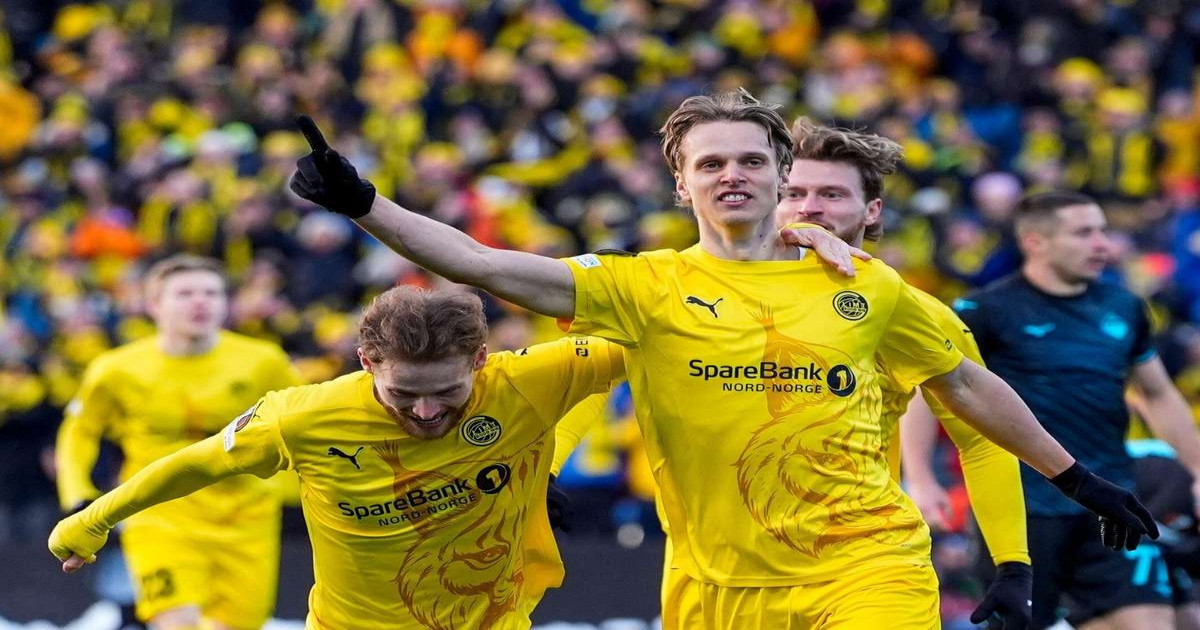A never-say-die attitude, unique training cultures, high-pressing tactics and a resistance towards bending into conventional methods have carried Bodo/Glimt, a team just north of the Arctic Circle, to the brink of the Europa League semi-finals as they face Lazio in the return leg on Thursday at the Stadio Olimpico.
All sports have their share of underdog stories. Leicester City won the Premier League, Detroit Pistons stunned the Lakers in the 2004 NBA Finals and the USA, with a team full of amateurs and college ice hockey players, took the mighty Soviets by surprise in the 1980 ‘Miracle on Ice’.
While such stories are unusual, perhaps especially for Scandinavian sides in a football world where the rich get richer and richer, their rarity is what makes them special, and while each one is unique, there is a familiar pattern to each story.
The stories are often dominated by innovative tactics, talented players with a true desire to make a difference, a charismatic coach with a bold vision and shrewd business management.
All of those factors you will find in a team at home in a city of 50,000 people just north of the Arctic Circle, a 16-hour drive from Oslo, further north than Iceland.
Kjetil Knutsen’s Bodo/Glimt are just 90 minutes away from securing access to the semi-finals of the Europa League after a 2-0 win against Lazio in the first leg a week ago.
Resemblance to ‘Murderball’
When Knutsen and his assistant Morten Kalveness arrived at the club in 2017, the club who went bankrupt in 2011 and was nearly wiped out through a Luftwaffe air raid in 1940, was notoriously known as an ‘elevator-team’ constantly involved in battles against relegation and for promotion in the no-man’s land between Eliteserien and the second division.
Today, the club has won the Norwegian championship in four of the last five years, and there is a never-say-die attitude in the team installed from a unique training culture with ruthless high-intensity training sessions bearing resemblance to Marcelo Bielsa’s non-stop drills known as ‘Murderball’.
The club has established a core identity through its home-grown players, such as the likes of playmaker Patrick Berg, captain Ulrik Saltnes and winger Jens Petter Hauge, all of whom have been developed in the club’s youth system.
“Half the first team are local boys,” said Orjan Berg, former player and current sports director, to The Athletic.
“We aim to have 40 per cent of our squad from northern Norway, and 15 per cent of playing minutes for local players. That is part of our identity. The fans want northern Norwegians to play.”
The road less travelled
The club talisman is undoubtedly the 27-year-old Patrick Berg, who rejoined the club last summer after a dismal six-month stint with French Ligue 1 outfit Lens.
Berg represents what is arguably Norway’s most well-known football family as his father, Orjan, as well as his uncles, Runar and Arild, all played for the club. His grandfather, Harald, is regarded as the best player in Bodo/Glimt’s history and took part in lifting the Norwegian cup in 1975.
Captain Ulrik Saltnes epitomises the club’s refusal to surrender. Saltnes considered walking away from the game altogether before the arrival of coach Knutsen in 2017, as he battled nausea and stomach cramps.
Today, he says that the squad is crammed with stories about players who have all been let down or injured or wanted to leave, which has turned Bodo into an incredibly tight unit that takes enormous pride in defying the odds.
Robert Frost’s line – ‘two roads diverged in a wood, and I took the one less travelled by’ – is symbolic of Bodo/Glimt’s way of doing things as a club, building an identity around taking a different path than all the others.
Whether it’s Knutsen’s open-minded approach towards including player ideas, their unusual Scandinavian possession-based football, morning meditation sessions before training or a focus on performance instead of results, it’s all part of a club which does not abide by convention.

Patrick Berg is Bodo’s talismanMarius Simensen / Bildbyran Photo Agency / Profimedia
Locating the X-factor
That is also core to their recruitment policy. Talents that may be overlooked by bigger sides because they are not the finished article are handed a chance to shine at Bodo, as explained by assistant coach Morten Kalveness.
“Does this player have the specific X (factor) that we are looking for? Will the player fit, and if not, can they be integrated anyway if they have a lot to offer?
“Can we build his development around that, and find a position in the team where we can really use it?”
That philosophy is focused on a tactical vision where players constantly rotate during the build-up. The team has adopted a dynamic approach where they constantly switch between formations to create numerical advantages and exploit spaces. Knutsen’s focus is always to get the players into positions where they can make the most out of their individual skills.
The results are there for everyone to see as UEFA statistics underline that it’s certainly not a coincidence that Bodo/Glimt has turned into a force to be reckoned with in the European club competitions.

Bodo/Glimt current formFlashare
Impressive statistics
If you look at parameters such as spending power, player value, spectator capacity and size of the city, Bodo/Glimt doesn’t feature at the top of the table. But if you look at the achievements in recent years, the Norwegians are as competitive as anyone in the Europa League.
Of all the teams in the Europa League, Bodo/Glimt have scored the most goals this season with 24, ahead of Lyon (23) and Real Sociedad (22). Further, Danish striker Kasper Hogh is the leading goalscorer of the tournament with seven goals (along with Ayoub El Kaabi from Olympiacos).
At the other end of the pitch, Russian keeper Nikita Haikin stars at the top of the list with 50 saves in the tournament, ahead of Viktoria Plzen’s keeper Martin Jedlicka (41). At the same time, Hakon Evjen leads the list of tackles made in the tournament (30) while Bodo/Glimt is also one of the top three clubs in terms of winning possession.
All those statistics indicate that Lazio could be faced with a mountain to climb if they are to get past the unsung Norwegians at the Olimpico.
In April 1991, the Olimpico turned into the centre of a Scandinavian nightmare when Rudi Voller’s 88th-minute goal crushed Danish outfit Brondby’s hopes of reaching the UEFA Cup final. Today, 34 years later, the Olimpico could become the next chapter in a Scandinavian fairytale if the arctic minnows manage to book their Europa League semi-final ticket at the expense of Lazio.
Follow Bodo/Glimt’s second leg against Lazio with Flashscore.



